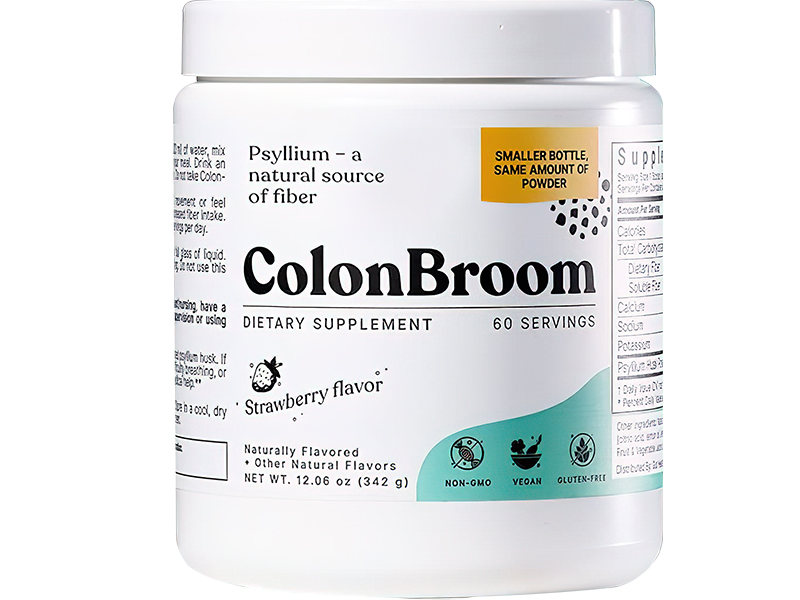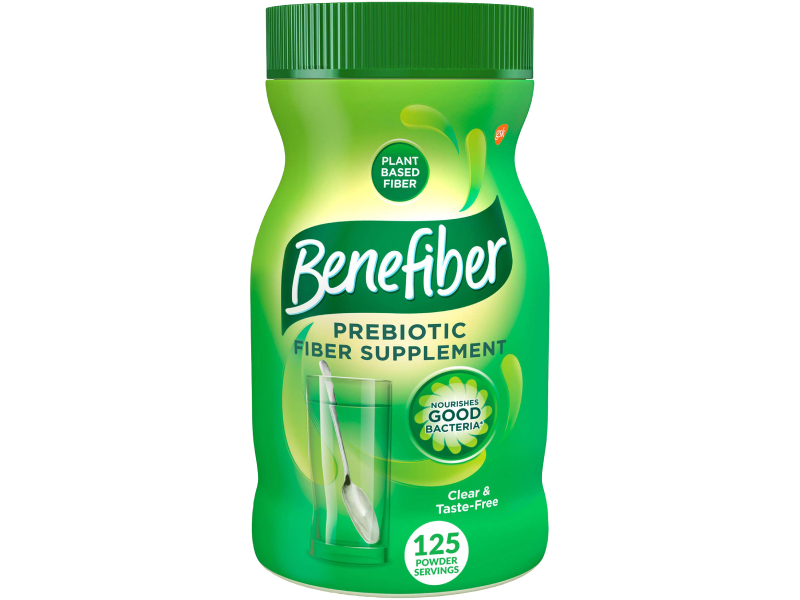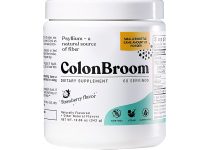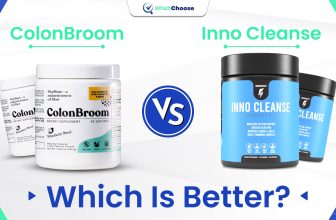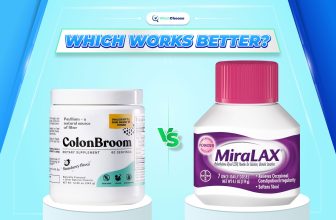Table of Contents
This post contains affiliate links. We earn an affiliate commission when you click our links to purchase products. It has no added cost to you.
Losing weight have never been so easy, right? I really know that because I used to struggled with my excess weight for a long time. After full-immersion experience many methods to shred pounds, I see you should first improve your digestive health. So, what is the best way to reduce bloating and constipation and help you lose weight? Try two options from WhichChoose: ColonBroom vs Benefiber. But if you do not know what exactly matches your needs and budget, stay tuned and read this article to get the comparison between both.

ColonBroom Vs Benefiber: Overview
Feel lighter.
Reduce bloating.
Boost metabolism rate.
Relieve constipation.
Lose excess weight.
Boost probiotic growth.
Decrease blood sugar levels.
Satisfaction guarantee.
Diet guide included.
Workout plan included.
App included.
Strengthen your existing gut bacteria to help optimize gut health.
Contain plant-based prebiotic fiber ingredients.
Dissolve completely, even in water.
Gluten- and sugar-free.
1.1. ColonBroom
First of all, let’s learn about the ColonBroom. ColonBroom is a fiber-rich supplement that contains ingredients shown to improve gastrointestinal health [1] and lessen instances of diarrhea. The ingredients may also help with detoxification by encouraging regular bowel motions. In addition to its already-recognized benefits, the ColonBroom Program (supplement, diet guide, workout plan, app) may has been shown to lower blood sugar levels, aid in weight loss, promote metabolic health, and speed up the body’s metabolic processes. In addition, it has received rave reviews from customers and has no gluten or animal ingredients.
This is because users with sensitivities will not experience any adverse effects from using this item. ColonBroom main ingredient, psyllium husk, is a bulk-creating laxative [2] that absorbs water in the colon, which helps with colon health, bloating, constipation, and probiotic [3] activity.
1.2. Benefiber
How about Benefiber? It is also a good choice for losing weight. Benefiber is a soluble fiber supplement sold over the counter. This product is a dietary fiber supplement [4] that comes in powder, tablet (both oral and chewable), and capsule form.
Ingredients
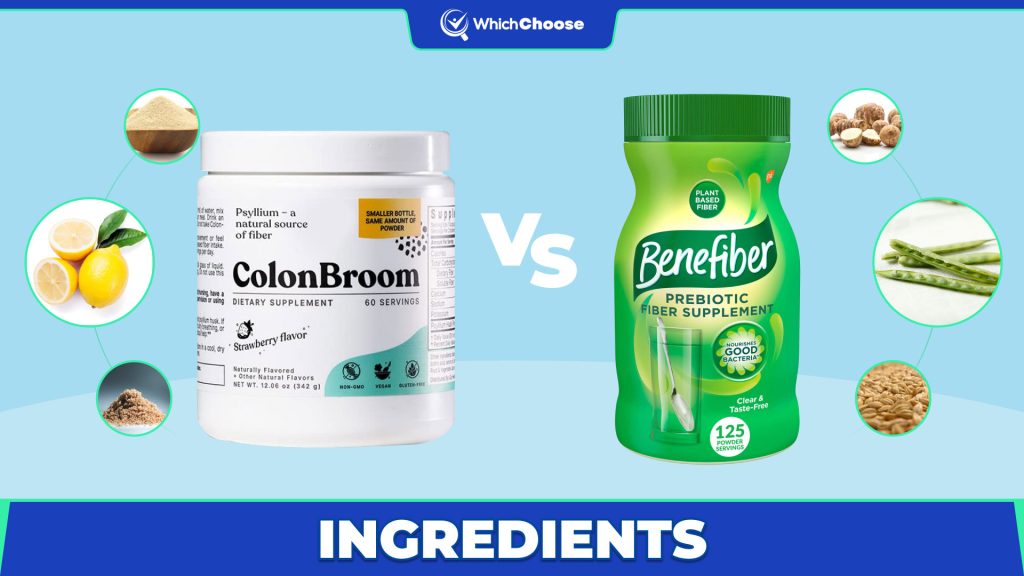
2.1. ColonBroom
What makes ColonBroom outstanding than others? It contains some key ingredients below:
- Sea salt and silicon dioxide have an impact on your overall health. This moderate salt [5] boosts hydration. But what is it? Hydration plays an important role in supporting kidney cleansing. Moreover, silicon dioxide [6] (SiO2), with a small particle, can help create and keep the substance fresh.
- Stevia: Stevia is the second name on the ingredient list of this product. The special point making ColonBroom the first choice of many people who want to lose weight is that its natural sweetness comes from stevia. This natural component lowers blood sugar [7] and cholesterol.
- Psyllium is a soluble fiber that absorbs water in the gut and develops into a thick, gel-like material that softens feces for a pleasant bowel transit. Furthermore, Psyllium husk [8] relieves constipation, watery diarrhea, bloating, and unpleasant flatulence.
- Crystallized lemon [9] (citric acid): The final crazy thing in ColonBroom is that natural flavorings give zest and tang to crystallized lemon. It’s also anti-inflammatory and antioxidant.
2.2. Benefiber
Regarding Benefiber product, it likely contains one of the following fibers:
- Inulin is found in onion, chicory, and wheat. This ingredient aids in weight loss by reducing hunger, which in turn helps keep calorie and food intake in check.
- Partially Hydrolyzed Guar Gum [10]: PHGG is a water-soluble prebiotic fiber from guar seed. Soluble fiber impacts intestinal function and stool production in liquids and meals.
- Wheat dextrin is also an ingredient worth mentioning in Benefiber. It is a soluble fiber that doesn’t modify food and drink texture. Glucoside connections allow it to travel gently through the digestive tract and ferment in the colon.
Pros And Cons
Each supplement has its benefits and drawbacks as well, so let’s compare the pros and cons of ColonBroom and Benefiber. Check the table belows:
The program may aid in weight loss.
Controls bowel motions.
Lowers blood sugar levels.
Reduces hunger and sugar cravings.
Enhances intestinal health.
Promotes healthy skin.
Lowers blood sugar levels, lowering the risk of developing diabetes.
Slow to see outcomes.
Available in a variety of sizes.
It completely dissolves in liquid.
Free of gluten.
Other medications are affected.
Dependence is possible.
Side effects have been reported.
Gluten-sensitive individuals may be allergic.
Dosage
4.1. ColonBroom
How to take ColonBroom in the right way and maximize its benefits? Here is how it’s done. You should mix one teaspoon or one scoop of powder with 8 ounces of water for a single serving of this product. Drink 30-60 minutes before a meal. Moreover, bear in mind that when you take your ColonBroom, it’s advised that you follow it up with a full glass of water.
4.2. Benefiber
Unlike ColonBroom, the recommended dosage of Benefiber is three times a day with two teaspoons at once in 8 ounces of water or a clear beverage. That’s easy to follow, right?
ColonBroom vs Benefiber: Side Effects

5.1. ColonBroom
The expectation from ColonBroom producers is that this product is totally safe when taken. Of course, everyone wishes that, don’t they? However, some consumers have noticed bloating after using this product. This symptom may require medical attention when it becomes more severe. Aside from bloating, ColonBroom has no significant side effects.
When taking ColonBroom, a small tip is to drink plenty of water. This will increase the supplement’s effectiveness. The high fiber content in it can cause constipation or acid reflux if not adequately hydrated.
Please notice this highlight attention: Pregnant, nursing, and trying-to-conceive women should consult a doctor before taking ColonBroom.
5.2. Benefiber
Benefiber is not picky about consumers. Most adults and children over 12 can use Benefiber without worry. Nonetheless, there are potential adverse effects of consuming too much fiber. Some unexpected symptoms include:
- Nausea.
- Stomach gas.
- Constipation.
- Stomach cramps.
- Diarrhea.
- Dehydration.
Price And Where To Buy
6.1. ColonBroom
A one-month supply of ColonBroom regular costs $64.99 with 60 servings. Is this price too high? Don’t worry! You can get an exclusive autumn sale of up to 65% OFF for 3 & 6 months with a subscription. More details are here:
- Option 1: One-month supply (1 bottle – sale 7% OFF): $64.99 per bottle + free diet guide, workout plan, ColonBroom app + free shipping.
- Option 2: Three months supply (3 bottles – sale 50% OFF): $35.99 per bottle + free diet guide, workout plan, ColonBroom app + free shipping.
- Option 3: Six months supply (6 bottles – sale 65% OFF): $27.99 per bottle + free diet guide, workout plan, ColonBroom app + free shipping.
You only get this exclusive sale if you buy on the ColonBroom official website. Moreover, it ensures you purchase authentic products and receive high-quality customer service.
Vegan and 100% gluten-free.
Boost metabolism rate & assist in weight drop.
Promote a rise in energy levels.
6.2. Benefiber
With a little bit higher than ColonBroom, Benefiber’s price ranges from free to $70, depending on where and what kind you get. For example:
- Benefiber powder costs $20 for 125 servings. At three servings per day, that’s 50 cents per day and $15 for a 30-day supply.
- Benefiber On The Go packs cost $1.23 daily, or $36.90 for 30 days.
- The most expensive was Benefiber chewable. Nine daily tablets costs $2.07 per day and $48 for 30 days.
Several stores provide Benefiber, and the list includes some of the most famous names in the industry: Amazon, Target, Walgreens, Costco, Walmart, and CVS.
Maintain digestion.
Include plant-based prebiotic fiber.
Strengthen gut bacteria to boost gut health.
Here is the final word about the ColonBroom vs Benefiber comparison: which is the best for you? Considering the health benefits, pros, cons, and side effects, ColonBroom should win this battle. Are you in agreement with WhichChoose? We hope you start taking gut health into your own hands!
10+ trusted sources:
WhichChoose relies on peer-reviewed studies, academic research institutes, medical associations, and strict purchasing guidelines. To ensure accuracy, we generally use peer-reviewed papers. Tertiary references are avoided. Please see our editorial policy for more information about how we make sure our content is correct and up-to-date.
- [1] Van T.Pham, SusanneDold, AteequrRehman, Julia K.Bird, Robert E.Steinert (2021). Vitamins, the gut microbiome and gastrointestinal health in humans. Nutrition Research Volume 95, November 2021, Pages 35-53. Available at https://www.sciencedirect.com/science/article/pii/S0271531721000580.
- [2] Jackson R, Cheng P, Moreman S, Davey N, Owen L. “The constipation conundrum”: Improving recognition of constipation on a gastroenterology ward. BMJ Qual Improv Rep. 2016;5(1).
- [3] Kirjavainen P V, Ouwehand A C, Isolauri E, Salminen S J. The ability of probiotic bacteria to bind to human intestinal mucus. FEMS Microbiol Lett. 1998;167:185–189.
- [4] Lambeau, Kellen V.; McRorie, Johnson W. (2017). Fiber supplements and clinically proven health benefits: How to recognize and recommend an effective fiber therapy. Journal of the American Association of Nurse Practitioners, 29(4), 216–223. doi:10.1002/2327-6924.12447.
- [5] Ross D Feldman; Nancy D Schmidt (1999). Moderate dietary salt restriction increases vascular and systemic insulin resistance. , 12(6), 0–647. doi:10.1016/s0895-7061(99)00016-3. Available at https://pubmed.ncbi.nlm.nih.gov/10371376/.
- [6] K R Martin (2007). The chemistry of silica and its potential health benefits. J Nutr Health Aging. 2007 Mar-Apr;11(2):94-7. Available at https://pubmed.ncbi.nlm.nih.gov/17435951/.
- [7] Jan, S.A., Habib, N., Shinwari, Z.K. et al. The anti-diabetic activities of natural sweetener plant Stevia: an updated review. SN Appl. Sci. 3, 517 (2021). https://doi.org/10.1007/s42452-021-04519-2.
- [8] Jalanka, Jonna; Major, Giles; Murray, Kathryn; Singh, Gulzar; Nowak, Adam; Kurtz, Caroline; Silos-Santiago, Inmaculada; Johnston, Jeffrey; de Vos, Willem; Spiller, Robin (2019). The Effect of Psyllium Husk on Intestinal Microbiota in Constipated Patients and Healthy Controls. International Journal of Molecular Sciences, 20(2), 433–. doi:10.3390/ijms20020433. Available at https://www.ncbi.nlm.nih.gov/pmc/articles/PMC6358997/.
- [9] Penniston, Kristina L.; Nakada, Stephen Y.; Holmes, Ross P.; Assimos, Dean G. (2008). Quantitative Assessment of Citric Acid in Lemon Juice, Lime Juice, and Commercially-Available Fruit Juice Products. Journal of Endourology, 22(3), 567–570. doi:10.1089/end.2007.0304. Available at https://www.ncbi.nlm.nih.gov/pmc/articles/PMC2637791/.
- [10] Niv, E.; Halak, A.; Tiommny, E.; Yanai, H.; Strul, H.; Naftali, T.; Vaisman, N. (2016). Randomized clinical study: Partially hydrolyzed guar gum (PHGG) versus placebo in the treatment of patients with irritable bowel syndrome. Nutrition & Metabolism, 13(1), 10–. doi:10.1186/s12986-016-0070-5. Available at https://pubmed.ncbi.nlm.nih.gov/26855665/.
WhichChoose is the website products and services review that helps users in the world to find what the best is and shop easily.


